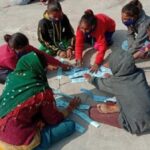Ramu Mahadu Gavate (42) hails from Ruichapada village, Jawhar administrative block in Palghar district. He could not complete formal education due to his circumstances. However, he has been engaged in farming from a young age, to support his family.
Farming has been his livelihood. His family of five is dependent on farming income. Uncertainties of agricultural income worried Gavate. The uncertainties have increased in recent years because of the impact of climate change.
But things started changing in the year 2015 when he got associated with the Maharashtra Gene Bank Project (MGBP). MGBP is an initiative in recognizing the diverse bio-resources that naturally occur the different agro-climatic zones of Maharashtra. Now Gavate is successfully involved in the conservation of non-timber forest produce species.
Gene bank project
The aim of Maharashtra Gene Bank Project (MGBP) is to ensure sustained availability of the diverse bio-resources for food and nutrition security of the local communities. It would also ensure livelihood and economic gains to the communities, at the same time building resilience against the growing threat of climate change.
MGBP focuses on participatory in-situ and ex-situ conservation, revival and management of crop landraces, livestock types and forestry species for harvesting non-timber forest produce (NTFP) essentially. MGBP covers a total of 92 villages across Maharashtra.

The NTFP species conservation is part of the MGBP and includes in-situ and ex-situ conservation, promoting sustainable harvesting of NTFP by adopting non-destructive harvesting methods, standardizing nursery techniques for mass multiplication and post-harvest management of NTFP.
Mahua, charoli, hirda, behada, karaya, bamboo and bauhinia were chosen as the seven priority species based on the conservation perspective, rarity and market value. In the Jawhar block, 11 villages were involved in the conservation measure.
Cultivation to conservation
Gavate used to cultivate vegetables and had jasmine plants in a part of his land. The sale of vegetables and flowers fetched him a little income. When he became involved in the MGBP, he became interested in conservation of non-timber forest produce species.
He visited Dhadgoan with the project team to learn mahua grafting techniques. He learnt nursery techniques as well. In the past five years, he has established two NTFP nurseries in his land. He has planted mahua, karaya, hirda, behada, bauhinia and bamboos in his NTFP nursery. He and his family look after the nursery.

He also raised a low-cost nursery in which nearly 9,000 seedlings were grown from 1 kg seeds of bamboo. These plants were distributed to villagers and also used for plantation under a habitat conservation program. Gavate shows enthusiasm in conservation and participates in every habitat conservation program.
Nursery as training ground
Gavate’s nursery is good for experimental learning and serves as a live gene center. He has become an important resource person for NTFP related activities. A training was also organized in his nursery, and experts helped other participants to learn mahua grafting techniques.
Scientists, farmers and students who visit the MGB projects also visit Gavate’s NTFP nursery. He has become quite popular in the region with his knowledge and work. Forest department as well as members of panchayat samiti seek his help when they want to establish a nursery.

He ensures that he performs all the monthly tasks and responsibilities assigned to him as part of the conservation program on time. With support from this project and his family, he is actively involved in conserving NTFP species through his nursery.
Financial stability
He still cultivates vegetables but is more involved with NTFP related activities. He earns between Rs 50,000 and Rs 60,000 per year as additional income through his NTFP nursery. In the next one or two years, he expects to earn around 1 lakh income from nursery related activities. It will be in addition to what he earns from his vegetable and jasmine cultivation.
Gavate’s hard work has improved his livelihood. He is happy with the successful NTFP nursery and conservation activities. They ensure steady income to support the social responsibilities and education of his children.
After the MGB project comes to a close, he will be able to maintain his source of income by utilizing the skills which he has learnt now. His hard work, determination and passion for doing something for his family and conserving nature will never let him down and he will continue to serve as a torch bearer.
Vitthal Kauthale and Sanjay Patil are associated with BAIF. Views are personal. Email: vitthal.kauthale@baif.org.in / sanjay.patil@baif.org.in








